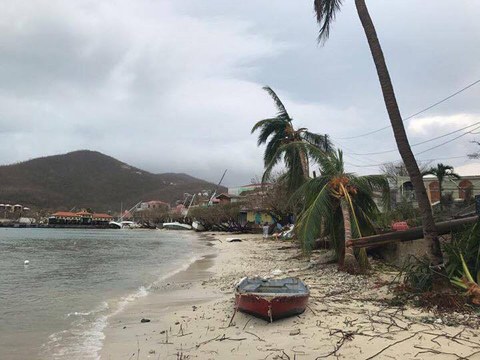BLEAK HOUSE: Gov. Kenneth Mapp is presiding over a 100,000-person territory with no money.
[ad name=”HTML-68″] [wpedon id=”23995″ align=”left”]CHARLOTTE AMALIE — The economic future of the Virgin Islands is in dire jeopardy.
The debt crisis, also affecting neighboring Puerto Rico, is hitting home in the territory, too.
By 2017, St. Thomas, St. John and St. Croix had accumulated so much debt that the bond market had refused to lend the islands any more money.
Gov. Kenneth Mapp was in the process of negotiating with the bond market again when Hurricanes Irma and Maria devastated the islands in September–storms that not only damaged much of the tourist industry, but decimated most of the islands’ infrastructure.
Nellon Bowry, Mapp’s Office of Management and budget director, recently told the U.S. Senate Committee on Finance that the 2017 budget already had a shortfall of $81 million.
In an effort to draw in much needed revenue to combat the budget deficit that the government was facing, in March of 2017, Mapp decided to sign several bills into law, most of which were connected to the edited Revenue Enhancement and Economic Recovery Act.
Included in this lawmaking by the governor was Bill No. 32-0007 which established a minimum baseline property tax of $360.00 after application of exemptions and credits.
And widely unpopular, the “sin tax,” also known as Bill No. 32-0005, authorized the collection of revenues on alcoholic beverages, sweet carbonated beverages, cigarettes, and timeshare unit owners.
These revenues did very little to lower the debt, as the core economic issues went far beyond applying a simple tax raise and austerity on citizens who were already struggling.
The territory’s 2017 debt pales in comparison to 2018 budget shortfalls, as the damage from hurricanes Maria and Irma raised this crisis to a new level.
Bowry also informed lawmakers that the 2018 budget shortfall was $453 million — and after adding the 2017 deficit of 81 million to this already staggeringly high number, the Virgin Islands are in debt to the tune of 534 million.
The U.S. government made an offer to lawmakers in the territory, and naturally, it came with strings attached.
The Community Disaster Loan bill (CDL) proposes to lend $500 million to the Virgin Islands, but in order to get the first $300 million, the local government would have to agree to pay back the federal government before it paid back its already delinquent bond market debts — the U.S. Treasury said that it will not accept a subordinate lien.
In 2016, the local government passed a measure placing a lien on the territory’s Matching Fund Revenue (MFR) bonds to assure that bondholders were paid first, thus making the acceptance of the CDL loan a giant risk for a territory that is not only facing an economic crisis, but a humanitarian one as well after Irma and Maria.
Senator Bernie Sanders has proposed a comprehensive solution.
Senator Kirsten Gillibrand, co-sponsor of Sanders’ bill S.2165, also known as the Puerto Rico and Virgin Islands Equitable Rebuild Act of 2017 would be known as the “New Marshall Plan.”
Similar to the old Marshall Plan, which was enacted in order to help Europe recover after experiencing utter devastation caused by World War II, Sanders’ bill is meant to provide a long term plan to deal with the damage caused by Maria and Irma in the Caribbean Basin, as Puerto Rico and the Virgin Islands.
Our territory and the commonwealth 120 miles north of St. Croix are in desperate need of significant help in order to rebuild sustainable infrastructure in the areas affected.
Sanders’ bill calls for $146 billion, which will be used to overhaul the islands’ energy, medical, and housing infrastructure.
It would also provide for debt relief and fund environmental cleanup, but will limit privatization with the hope that dubious one-sided deals like the Whitefish Energy scandal, can be avoided in the future.




